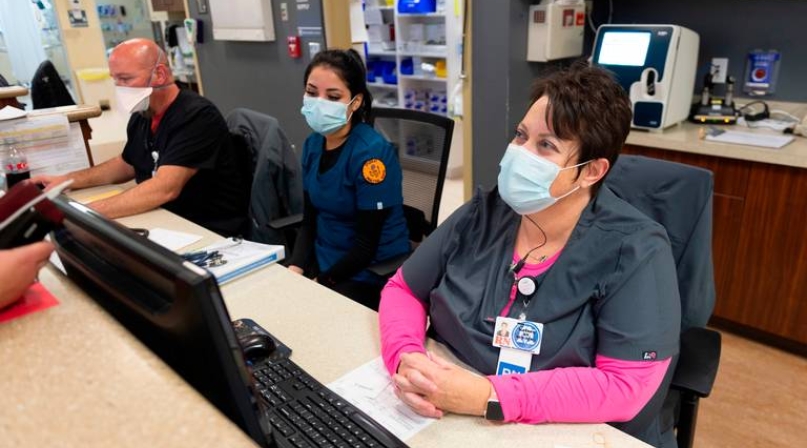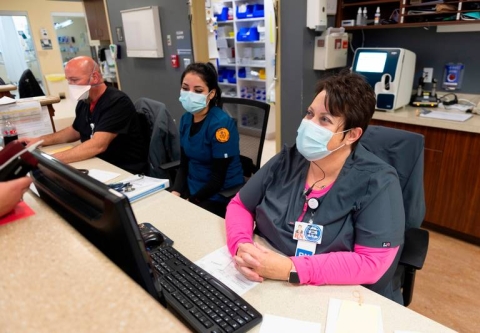As COVID-19 surges, county hospitals face staffing challenges, space shortages
Author
Upcoming Events
Related News

Key Takeaways
Nationwide hospitalizations for COVID-19 patients reached an all-time high at the end of November.
Over 90,000 individuals were hospitalized across the United States with the coronavirus in the last week of November, setting a record-breaking number for hospitalizations during the pandemic, according to the COVID Tracking Project.
The Centers for Disease Control and Prevention (CDC) reported the overall weekly hospitalization rate is now at its highest point in the pandemic.
“Our hospital is full,” said Dr. John Fankhauser, CEO of the Ventura County, Calif. Medical Center.
The county-run hospital is beyond capacity for adult medical surgical space and is holding patients in the emergency room each day as the facility experiences an uptick in emergency room visits, he said.
The Ventura County Medical Center is utilizing an overflow area in a vacated facility that used to serve as the former hospital.
Over a 12-day span, the number of COVID-19 patients jumped from one to 16.
“We’ve restored one floor of that hospital, so we have been using that throughout the crisis for overflow and it’s currently 100 percent capacity, so we’re looking to staff additional beds in that overflow unit,” he said.
The medical center has nine ICU beds, nine telemetry beds, 12 definitive observation unit beds and 48 general medical/surgical beds.
Fankhauser works with other hospitals throughout Ventura County to discuss capacity challenges.
He said the Ventura County Medical Center is one of the hospitals that will expand capacity if needed.
“We’re prepared to bring more patients in and we purchased more beds for that space,” he said.
The hospital’s greatest challenge is staffing.
“We have a really significant challenge finding the staff that are needed to staff the ICU and the medical surgical units,” he said.
In anticipation of an increased number of COVID-19 cases through the winter, the hospital has a surge plan that includes contracts with registries and visiting nurse agencies to provide more staffing and the repurposing of vacant space if necessary.
“The surge is real and this is something that can affect all of us,” Fankhauser said.
Erica Murray, president and CEO of the California Association of Public Hospitals and Health Systems, said county-run hospitals throughout California are seeing a sharp uptick in cases and preparing for rises in hospitalization numbers.
“There’s typically a lag between a spike in cases and hospitalizations, so I would characterize the situation for California’s county hospitals as ‘braced,’” she said.
Murray said one of the benefits of being a county hospital is the strong connection to other county departments to coordinate supplies.
She agreed with Fankhauser that the greatest challenge is with staffing. Earlier in the pandemic when there were high numbers of cases throughout California, other locations had relatively low numbers which allowed for flexibility with staffing.
“Now with everyone in crisis mode and nurse registries drying up, the potential for health care workers themselves to get sick and just the very understandable fatigue and burnout of a marathon and not a sprint, staffing levels are a huge concern,” she said.
Murray said county hospitals are prepared for a potentially larger outbreak this winter from the experiences they had with surge preparation in the spring. The situation has left many county hospitals planning for the worst, but hoping for the best.
“What we’re seeing are numbers and the greatest fear is that those numbers are going to translate into patients and that we’re soon going to be overwhelmed,” she said.
In Minidoka County, Idaho, Emergency Management Coordinator Kim Vega also serves as the emergency management director for Minidoka Memorial Hospital, a county-run critical access facility.
Vega said the hospital has been seeing an increase in cases over the last few months with an average of three to four COVID-19 patients each day at the emergency room department.
With 17 beds and three specifically for COVID patients, Vega said the hospital can treat COVID patients unless they need a ventilator, in which case they will be sent to other hospital facilities located 40 miles away.
However, Vega explained that other hospitals in the area are facing their own capacity challenges and are sometimes unable to admit additional patients.
“With all of south central and eastern Idaho being hit so hard, it’s getting to the point where it’s harder and harder to find places to send patients,” she said.
Staffing has also proven to be a challenge for the hospital.
“It’s hard to run a small community hospital when so much of your staff is out,” she said. “Our biggest issue hasn’t been that we don’t have enough room, it’s been we don’t have enough staff.”

Attachments
Related News

CMS issues new guidance on Medicaid Community Engagement Requirements
On December 8, the Centers for Medicare & Medicaid Services (CMS) released a Medicaid and CHIP Services Informational Bulletin (CIB) directing states on how to implement the Medicaid community engagement requirements enacted under Section 71119 of the One Big Beautiful Bill Act legislation (Public Law 119-21), or H.R. 1.

California county sales tax measure backfills federal healthcare cuts
Santa Clara County, Calif. will raise an estimated $330 million each year from a sales tax to backfill lose Medicaid funding.

